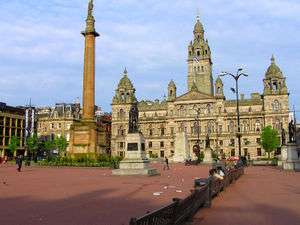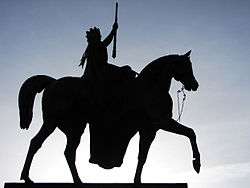George Square


George Square is the principal civic square in the city of Glasgow, Scotland. It is named after King George III. Laid out in 1781, George Square is today home to the headquarters of Glasgow City Council, and boasts an important collection of statues and monuments, including those dedicated to Robert Burns, James Watt, Sir Robert Peel and Sir Walter Scott. It is generally regarded as the de facto centre of the city, although Blythswood Square (1 km to the west) is the true geographical centre of the city, whilst all distances are measured from nearby Glasgow Cross.
Historical development
George Square was laid out in 1781, part of the innovative Georgian central grid plan that initially spanned from Stockwell Street east to Buchanan Street—which reflected the growing rational influence of the Scottish Enlightenment, along with the similar development of Edinburgh's New Town. This grid iron masterplan across the lands of Meadowflats and eventually as far west as Blythswood Hill, was largely the work of the notable contemporary architects James Barry, James Craig and James Gillespie Graham.
For the first few years however it was little more than a muddy hollow, filled with dirty water and used for slaughtering horses. Between 1787 and the 1820s, the square was eventually opened up and lined with Georgian townhouses at its east and west ends, as well as hotels. 1842 saw the opening of Queen Street Station as the Glasgow terminus of the Edinburgh and Glasgow Railway. By 1850 the surrounding area had become a centre for mercantile activity, with the Merchants House moving to the square in 1877, and the square itself, which had been developed into a private garden for the surrounding townhouses, became an established public space, after frequent disturbances and pulling down of railings by a disgruntled mob.
The square was named after King George III, a statue of whom was originally intended to occupy the centre of the square, but the turmoil and anxiety caused to the city's Tobacco Lords by the War of American Independence in 1775 and eventual British defeat in 1783, coupled with his ever more frequent bouts of madness had created mixed feelings toward the Hanoverian and so it was decided instead to commemorate Sir Walter Scott, which, incidentally, was the first ever memorial dedicated to him.[1] The 80 foot Doric column is by Alexander Handyside Ritchie, "an architectural sculptor of genius", and the sculpture of Scott above it was by John Greenshields. Both were completed between 1834–37, some years before Scott was commemorated in Edinburgh.[2]
Prominent buildings

Today the east side of the square is dominated by the ornate Glasgow City Chambers, headquarters of Glasgow City Council, which opened in 1888. On the South side are a number of buildings, including the former General Post Office, built in 1878 and redeveloped into offices in 2007,[3] a Chicago-style office building, dating from 1924 and there is also the city's main Tourist Information Centre.
The North side consists of Queen Street Station, the North British Railway Hotel (now the Millennium Hotel), which date from the 1840s, and George House, which replaced an older Georgian building, built in 1979 to provide extra office space for Glasgow City Council, and now the offices of Ernst & Young.
Queen Street, running parallel to the square's West side, features the Merchants House building, in which is located the Glasgow Chamber of Commerce, which was designed by John Burnet and opened in 1874, two storeys were added by JJ Burnet in 1907 and are topped by a domed tower on which is perched the emblem of the House a ship on a globe, a reminder of the importance of sea trade to Glasgow's prosperity. The western side is also the location of the former Bank of Scotland building, which is now offices and a Wetherspoons restaurant and bar.
The eastern side of the square itself is flanked by two lawns and is also the site of the city's Cenotaph, which was designed by JJ Burnet and originally built to commemorate Glaswegians killed in the First World War when it was erected in 1922 by the Earl Haig Fund. An 80-foot-high (24 m) column in the centre features author Walter Scott, which was erected in 1837. Many of Glasgow's public statues are situated around the square and include the only known equestrian statues of a young Queen Victoria and her consort Prince Albert, poets Robert Burns and Thomas Campbell, inventor James Watt, chemist Thomas Graham, generals Sir John Moore, Lord Clyde and politicians William Ewart Gladstone, Robert Peel and James Oswald.
Social history
The square has often been the scene of public meetings, political gatherings, riots, protests, celebrations, ceremonies, parades and concerts. Perhaps the most famous was the 1919 Black Friday rally, when campaigners for improved working conditions (particularly protesting a 56-hour working week in many of the city's factories) held an enormous rally, with at least 90,000 protesters filling the square and the surrounding streets. The meeting descended into violence between the protesters and the police, with the riot act being read. The city's radical reputation, and the raising of the red flag by some present, made the Liberal government fear a Bolshevik revolution was afoot. The government responded by deploying fully armed troops and tanks into the square and the city's streets.
The square later provided a home to political hustings and meetings of all sorts, protests against the Poll tax and Iraq War, annual Remembrance Day parades and has lately become the venue for the city's extensive Hogmanay celebrations.
In February 2005, the square was closed to pedestrians for a two-month restoration project, including the replacement of the red asphalt concourse, and the cleaning of stone and the statues in the square, most notably that of Walter Scott.
In the winter months an ice rink is a prominent feature.
The decision to remove the greenspace and sell the area for temporary businesses and events has been controversial. In 2012 a campaign was started to restore the square to its previous state.[4]
In the immediate aftermath of Margaret Thatcher's death, there were efforts to organise street parties in celebration. In response to plans to celebrate in George Square,[5][6] Glasgow City Council issued a statement which read: "Regardless of whether or not it's appropriate to have a party to celebrate someone dying, this event was organised without involvement or consent from the council and we have safety concerns for anyone attending. Organisers of legitimate events must get permission to use the square. They must also satisfy the council that they will take safety precautions such as providing first aiders, sufficient public toilets and stewards, as well as obtaining public liability insurance. We urge people to stay away."[7] Over a hundred people were estimated to have arrived after half an hour.[6] Police Scotland said they would "police appropriately".[6]
During the Scottish Independence referendum of 2014, George Square was a popular destination for political hustings, particularly amongst supports of Scottish independence.
In December 2014, a bin lorry crash took place in George Square, killing 6 and injuring 10.
Future
In 2012 Glasgow City Council voted to spend £15m on a "makeover", of the square, in preparation for the 2014 Commonwealth Games, to make it "a place fit for the 21st Century".[2] The plans include removing all of the monuments and statues in the square, ostensibly for restoration. However, the council say that "it is possible" that the monuments "may not return to the square", but will rather be relocated to "an area of regeneration".[2] Only one monument is certain to remain; the Cenotaph by Sir John Burnet.[2]
On 9 January 2013, the six shortlisted designs were put on display to the public on the 5th floor of a gallery located down an alley a quarter of a mile away from the square itself. All the designs featured at least half the statues returning, with many containing all 11. Each short-listed design also contained a water-feature, which public reaction has been highly critical of considering the typical weather Glasgow experiences. The competition proved highly controversial with the abandonment [8] being reported on the same day as the winner - John McAslan & Partners [9] - was announced.
Notes
- ↑ http://www.glasgowsculpture.com/pg_biography.php?sub=greenshields_j
- 1 2 3 4 Private Eye No 1324, p.14, Nooks and Corners, 5–18 October 2012
- ↑ The History of G1 Glasgow G1 George Square Glasgow
- ↑ Restore George Square website
- ↑ "Thatcher's Deed - Party in George Square - Tonight!".
- 1 2 3 "Scores gather in Glasgow for 'party' to mark Thatcher's death". 2013-04-08. Retrieved 2013-04-08.
- ↑ "Council response to social media comments about Baroness Thatcher and George Square". 2013-04-08. Retrieved 2013-04-08.
- ↑ Glasgow Architecture George Square Competition
- ↑ e-architect John McAslan & Partners
References
- Private Eye No 1324, p. 14, Nooks and Corners, 5–18 October 2012
External links
| Wikimedia Commons has media related to George Square. |
Coordinates: 55°51′40.179″N 4°15′0.64″W / 55.86116083°N 4.2501778°W
